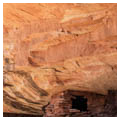The cluster of structures at Moqui Canyon have much to tell us about early Anasazi life in Utah. The centerpiece of the ruins is a group of three habitation and burial sites, tucked into the canyon but spread over an area approximately 2.5 miles in diameter. Another cluster, about 12 miles away, consists of four small, food-production campsites in a small tributary leading to Moqui Canyon. The final related site includes two storage areas far from the habitations, several miles down the canyon and several miles upstream. Archaeologist William D. Lipe, who has studied Moqui Canyon extensively, notes that these dispersed sites must be viewed as one entity since early Anasazi groups tended to utilize resources of a wide area.
The habitations are located in natural shelters, such as alcoves and shelves, near the upper end of the canyon. Here, the location was undoubtedly dictated by the rich deposits of floodplain alluvium and a concentration of springs above the mouth of North Gulch area. The walls of all three shelters are decorated with painted pictographs and each also contains a midden (refuse heap). At two of the shelters there is evidence of fire. These sites do not have any specialized storage structures though one did include a cache of dried corn on the cob.
Lipe believes that each site was occupied by two to four families at one time. Evidence at the burial sites, specifically remains of an elderly male, adult female, and an infant in the same grave, indicates that these were most likely multiple generations of a single family. Lipe has recorded twenty burial plots within the cluster.
The food production sites contain two kinds of implements used for grinding cereals and other edibles: sandstone slabs and one-handed manos, much like a pestle. In Lipe’s interpretation, these were probably not farming sites but were used for gathering and preparing wild seeds, perhaps rice grass or millet, which is fairly common in the canyon dunes. Groups of men and women probably gathered the seeds; women were responsible for grinding seeds and powdering rice. While women engaged in food preparation, men most likely made and repaired hunting equipment, given the number of projectile points found at the site. Other tools, including chips, cores, and hammerstones, were probably used by both men and women.
Of the two storage sites included in the Moqui Canyon cluster, the storage cave is located well downstream from the habitation sites and the storage alcove is upstream from them. Both contain pits and jar-shaped cists dug into the hardpan floors of the shelters. The storage cave, known as Echo Cave, contains 16 storage spaces that range in diameter from a few inches to more than 5 feet. The storage alcove, called Honeycomb Alcove, contains 58 pits and cists. These, too, range in size from a few inches to more than 3 feet in diameter. A bundle of unworked bighorn sheep bones and pieces of juniper bark and yucca matting were discovered at the site. The latter was probably used as a wrapping for the items stored in the alcove. Nothing at the site indicates habitation; there is, for example, no trace of fire.
Lipe believes that Echo Cave and Honeycomb Alcove were also used to store hunting and gathering gear, as well as materials used for cultivation. It is not clear why the storage caves and alcoves are at such a distance from the habitation sites. One hypothesis is that it may have something to do with the demands of the food-collecting component of the subsistence pattern, or with the cultivation of outlying fields. Another is that locations were determined by the presence of suitable hardpan floors. The separation of the sites from one another suggests that the entire local community had access to them. It should be noted, however, that the storage caves and alcoves found in Moqui Canyon are not common in the region.
References
Lipe, William D. “Anasazi Communities in the Red Rock Plateau.” In Reconstructing Prehistoric Pueblo Societies, edited by William A. Longacre, 84-139. Albuquerque: University of New Mexico, 1970.






